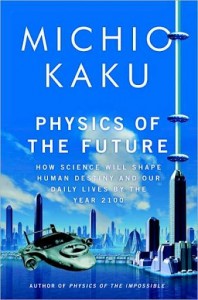
Have you ever dreamed of a world in which you could access the Internet with just the blink of an eye, fantasized about a future in which cancerous tumors could be removed with a simple press of a button, or swooned over a reality in which the prospect of living hundreds of years was truly within reach? In his well-crafted and accessible book, Physics of the Future: How Science Will Shape Human Destiny and our Daily Lives by the Year 2100, Michio Kaku grapples with the feasibility of these technologies and several other revolutionary developments.
As one of the founders of string theory, Kaku has been a pioneer of modern science, yet he breaks the scientific mold by writing this book for the broader public audience. The organization of the work is structured in a simple and straightforward manner. Kaku divides his book into eight distinct sections, ranging from the “future of the computer” to “nanotechnology” to the “future of space travel.” Each of these subsections is further separated into three time periods: the near future (present day to 2030), midcentury (2030 to 2070), and the far future (2070 to 2100). While some would assert that this structure is oversimplified, his organizational technique effectively streamlines the content in an easyto- follow format. Additionally, Kaku dedicates his final chapter to “A day in the life in 2100,” which provides a compelling synthesis of the main arguments of the book.
However, the book truly shines in the nuances of the prose. Kaku is one of the few scientific writers who is able to seamlessly blend technical arguments, such as those concerning the future of technology, with a truly captivating writing style. Kaku creates an enthralling world of thought, revolution, and, of course, discovery. He grips the reader from the get-go by weaving a tantalizing tale in which our very existence has been transformed. In this futuristic world, artificial intelligence controls all facets of life, from the interior design of our rooms to the driving of our cars; our contact lenses have been programmed to access the Internet at the speed of our thoughts, and we can take an elevator through the heavens into outer space. Through these descriptions, Kaku creates a world that rekindles the imagination and discovery many of us have not felt since childhood.
Although the imagery of the text seems entirely mythical, Kaku bases each of his arguments on prominent modern theories and develops his ideas in a logical progression. He delineates his predictions by looking at irrefutable facts and projecting them into the future decades and then analyzes their retained validity and functionality. For example, Kaku starts his narration by examining Moore’s Law, which states that every 18 months, computing power doubles in size and predicts its inevitable failure within the next few decades. It is safe to say that due to the writing, readers want to believe Kaku, and thanks to his convincing, evidence-based justifications, they can.
Yet, while minor, there are several flaws in Kaku’s writing. First off, while most of Kaku’s sections integrate theory and imagery well, he occasionally becomes carried away in his musings of the future world, exaggerating the effects of certain theories and making some parts seem more science fiction than actual science. Additionally, when Kaku speaks on controversial topics such as climate change and natural conservation, he blatantly adds his own opinion into his discussions, offering ultimatums that seem out of place in a scientific book. These lapses of consistency ultimately detract from the validity of Kaku’s arguments; however, these flaws are few and far between, and do not affect the overall impact of the work.
There are few works quite like Kaku’s, for he has struck a balance between accessibility and validity within the scientific genre. He shares his blazing vision for the future of mankind, revealing how our daily routines will be fundamentally transformed. Through this work, Kaku leads us to learn and believe – but, most importantly, he leads us to think. We are once again reminded of the sheer number of possibilities that scientific development can explore within the next century. Overall, this is an educational and enjoyable book, which is a must-read for those interested in the direction of our technological advancements and where they will carry us in the foreseeable future.
Book Information
Publisher: Doubleday
ISBN: 978-0-385-53080-4
